#orocovis
Explore tagged Tumblr posts
Text
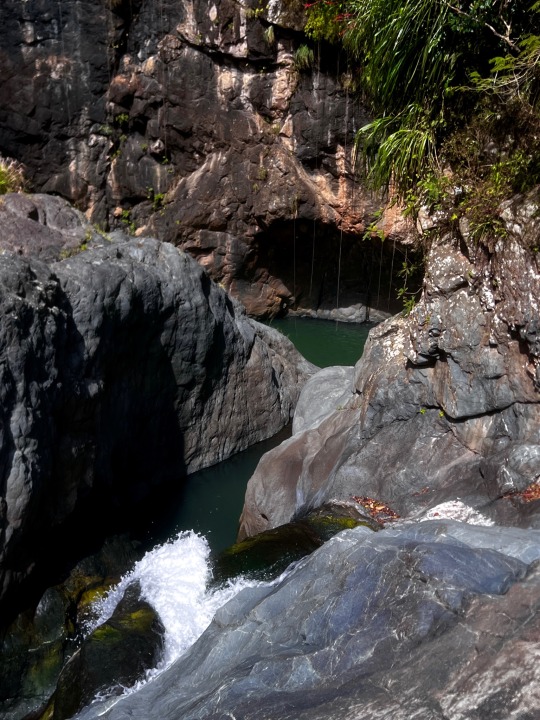
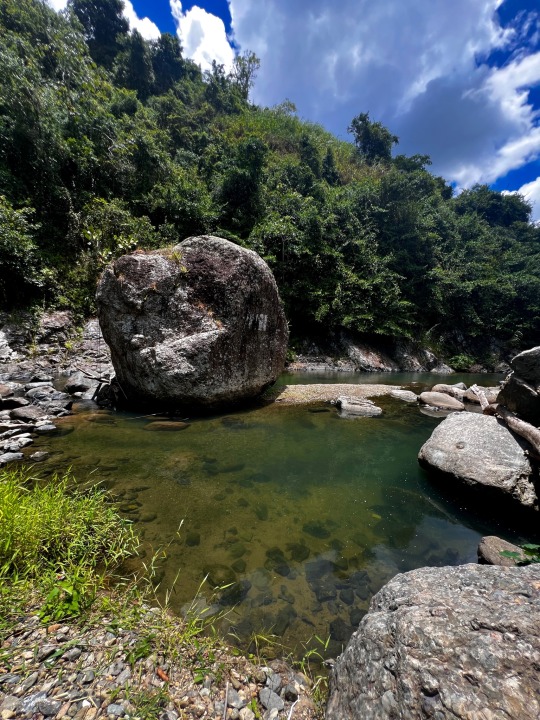

La Caldera, Orocovis
30/julio/2024
35 notes
·
View notes
Text
Muere trabajador por desprendimiento de terreno en Orocovis
Un trabajador de la construcción murió al desprenderse el terreno donde tomaba unas medidas durante la tarde de hoy, miércoles, en la carretera PR-157 del sector Los Ayala en el barrio Damián Arriba, en Orocovis. Las autoridades fueron alertadas del accidente a las 1:37 p.m.de hoy, miércoles, cuando Jaime Obed Rodríguez Ramírez, de 43 años de edad, tomaba las medidas para construir un muro de…
0 notes
Text
HOMBRE RESULTA HERIDO CON CUCHILLO DURANTE PELEA EN NEGOCIO DE OROCOVIS
Un hombre identificado como Sebastián Sánchez Rodríguez, de 27 años, resultó herido con un arma blanca en medio de una pelea ocurrida alrededor de las 10:00 de la noche del sábado en los predios del negocio Trabcia Cycle Bar, ubicado en la calle Ernesto Ramos Antonini, en Orocovis. Según la información preliminar, Sánchez Rodríguez se encontraba jugando billar cuando se originó una discusión…
#agresión con arma blanca#apuñalamiento en negocio#bar en Orocovis#herido con cuchillo#incidente en Trabcia Cycle Bar#noticias de violencia#Orocovis#pelea en bar#policía puerto rico#Sebastián Sánchez Rodríguez
0 notes
Text

🇵🇷 What a day! I got to go zip lining for the first time! ⛰️
#zip lining#Toro Verde Adventure Park#Orocovis Puerto Rico#mountains#Monday afternoon#sightseeing#i believe i can fly#I believe I can touch the sky#Christmas vacation
2 notes
·
View notes
Text

flickr.com
Black Knight
PACIFIC OCEAN (Jan. 8, 2022) Senior Chief Aviation Boatswain's Mate (Handling) Wilmarie Torres, from Orocovis, Puerto Rico, directs an F-35C Lightning II assigned to the "Black Knights" of Marine Fighter Attack Squadron (VMFA) 314 on the flight deck of the aircraft carrier USS Abraham Lincoln (CVN 72). The Abraham Lincoln Carrier Strike Group, led by Carrier Strike Group 3, deployed from San Diego on Jan. 3 in support of global maritime security operations. An integral part of U.S. Pacific Fleet, U.S. 3rd Fleet operates naval forces in the Indo-Pacific and provides the realistic, relevant training necessary to flawlessly execute our Navy’s role across the full spectrum of military operations — from combat operations to humanitarian assistance and disaster relief. U.S. 3rd Fleet works together with our allies and partners to advance freedom of navigation, the rule of law, and other principles that underpin security for the Indo-Pacific region. (U.S. Navy photo by Mass Communication Specialist 3rd Class Michael Singley)
17 notes
·
View notes
Text
This past week I’ve been distracted. Overwhelmed. Distressed. Worried. Anxious. Angry.
And Friday I was trying hard not to have those emotions be my fuel during what was to be our last sparring practice before our big State tournament.
To stay calm. Breathe. Be present.
It was a bigger challenge than I thought it would be.
Each round I could feel frustration mounting. Especially as nothing was landing. I couldn't get into a rhythm. And kept getting hit in a way that made me angrier by the second. But I held back. Trying to maintain control. To focus and not let the anger spill over. Then, somewhere near the end of round three, I lost focus and a foot slammed my ring finger.
I felt the pain and told myself to suck it up. Push through. But halfway through the round I knew between my frustration and the pain I wasn't in the mental state to put up a good fight.
And forced myself to admit defeat.
To accept the reminder of what happens when you allow frustration, anger, and fear to distract you.
You get hurt more than the person you are in opposition with - especially if they are prepared...
...I have been spending a lot of time listening to reports, reading articles, sorting through news from multiple outlets, trying to get a really good picture on what has been happening.
To sort through what is propaganda and what is factual.
And it’s been hard.
Hard because you don't know who to trust anymore for honest journalism.
Hard because you know that any opinion you share now risks alienating people you truly care about while putting self and others at risk of being treated as something less than. As people continue to struggle with listening to views in opposition of their own. Auto-rejecting because the narratives are painful, sting, or make them question everything they knew about life. I get it.
Hard because everything I’ve been reading and seeing and hearing goes against my own moral principles and philosophy. Against what I had been taught was just and right. And yet, only reinforces the experiences I have have had being raised a second generation, US-born Puerto Rican. And it would be so easy to believe that I have nothing to be worried about. I am a U.S. born citizen.
As is my father, who was born in New York where Abuelo Miguel and Abuela Lola met--both of whom were part of the Puerto Rican diaspora who moved to New York in search for better opportunities as factory workers. Only to find themselves moving back to Ponce after a bullet from outside flew through the wall and killed my dad's baby brother in his crib. Something they never really recovered from as a family.
My mother is a statutory U.S. Citizen born and raised in the then more isolated mountains of Orocovis, PR. Who, after graduating from UPR, moved in temporarily with my aunt who's then husband was station in one of the Southwest states.
My parents met in the US and the rest is the start of my own American-born history.
But while my identity as a kid was purely as a forever military brat and cradle Catholic, there was always this layer of "Us" vs "Them". I was American, educated on American grounds, in an American school - and yet my mother tried very hard to ensure we knew we were not "American" in the cultural sense.
To her, "American" kids were too "free" to do what they wanted. They had a lot more rights and privileges. To act like them was to reject where I came from. But even so, by late elementary school I couldn't understand. I wasn't born in Puerto Rico. I was a heritage speaker so I couldn't read Spanish well much less speak it. Outside my skin color, you couldn't even tell I spoke Spanish unless I tried.
And as my cousin's would remind me back then - I sounded "American" when I did.
But growing up overseas, I was proud to be an American.
The American flag was everywhere. We were always excited to watch the military base parades, and I was surrounded by soldiers and spouses, many who became extended uncles and aunts.
I was the proud daughter of a soldier and in my world, we were all united in our Patriotism even as we (kids) argued over which branch was the best.
The on base church was our second home, the priests - our dinner guests, and every day we were surrounded by people from all over the world coming together to talk about charity and how to live a good life in Christ.
And when parents stationed at our base had to go on tours, all the spouses would get together to pray and do food potlucks as a way to support each other while the soldiers were away. We ate all kinds of food, too. Learned how to make lumpias, put together tamales, and even native alaskan foods. This. This was the melting of cultures that made America so great.
But, when I moved from Germany to Florida after my dad's retirement, it was a different world.
I was lost, confused. Church catechism classes were lead by a large seemingly always-angry white man who railed against modern vices as we learned about the rite of confirmation.
Spanish language catechisms were criticized, and later shut down as unnecessary. "They can learn English," they would said when my mother tried to fight for the ability of immigant children to learn and follow Catholic teachings as their parents worked and adapted to life in the US.
Youth group was run by white, born-again Christians who judged us for asking questions that didn't follow their theology to the letter.
It didn't matter that we were still young and curious and had a different perspective.
And in school, instead of being celebrated and asking how to say something silly, speaking another language became an invite to bullying and jokes about your heritage.
I felt like I didn’t belong anywhere.
But the bullies knew.
With skin that darkens in the sun, in the end I belonged with the Latino kids.
Welcome to life in Southwest Florida.
This was America.
This experience forever shattered my views of what it meant to be an American. And why I became so involved in my college years in heritage groups like the Hispanic American Student Association, the Filipino Student Association. I led a Future Minority Leaders club.
And became heavily involved as a volunteer at the Hispanic Chamber of Commerce of Metro Orlando. This all led me to join a Latina-based Sorority, and even there, I eventually took on the role of Regional Director for many years.
Because all of these experiences had taught me a very long time ago that mainland America didn't care about me as a Latina.
My friends did.
The community I built and continue to build around me do.
But America? It didn't care.
I may not be an immigrant and lived the immigrant experience. But I grew up around immigrants and my life has been richer for it. Mr. Jerry Stipek and his wife were immigrants from the Czech Republic. There, he was a musician, but when he moved to the US - he had stopped writing scores.
When my mother found out and told him my siblings and I were in music - we became his muses. He played the organ during the English Mass, and soon we became a family quartet. My sister on the violin. My brothers as alto and soprano (because my youngest brother was still little). Myself on the flute.
I felt like a paraded peacock but my mother believed in us using our talents for the community. It was a community that rejected us in one way, but when it came to something universal - like music - we were welcome. But even then, it always felt like it was from a distance.
Just this past December, after years of effort my own Sister-in-Law became a U.S. Citizen. It was scary, as my brother had to join her on a trip to Mexico for the final leg. This after having to take matters into his own hands and switching lawyers due to careless handling of her case.
We didn't know what the outcome would be. We were on standby, just in case. And there is a relief knowing that she was approved.
During that time, another family friend who immigrated from Central America also came to visit my mother. They had good news to share themselves. They were approved for citizenship.
Seeing what’s happening now - I am reminded of these experiences. And it hurts me to see bullying and hate rewarded and applauded to this magnitude.
To hear of raids in Churchs, elementary schools, university dorms, and court hearings.
And not just Latinos. Those in the APAC community as well are being affected.
Places where people are trying to learn, work, and contribute.
To hear of legally approved visas suddenly being rescinded and renewals rejected. With agents immediately going to round them up for deportation as if they did something wrong.
When they were following the system. Believed in the system.
Were doing the right thing.
To hear immigrants who are being intentionally blocked from critical court hearings. To the point a CATHOLIC BISHOP has made a call to action for other people of faith to walk alongside them and keep them safe.
To hear that racial profiling is rule of ICE Law, and anyone speaking Spanish runs risk of being stopped, searched, and immediately deported. Regardless of citizenship status.
You just happened to be at the wrong place at the wrong time. And you happen to have the wrong skin color.
To have a President in power who encourages and is happy this is happening. And unhappy it isn't going faster. Isn't bigger, but then reverses course only when white-owned construction and farming businesses start crying shame as they lose their low-wage workers.
This is not about borders, or criminals. It never was.
It's the same playbook I've seen at work. In school. And yes - even in American-led churches.
This is why I stand with Immigrants. Because I believe in the version of America I saw in my youth when I lived overseas and on the military bases. I believe in the right-side of history - the one that people have not learned because it was inconvenient and erased. To not repeat the mistakes of the past and learn from it.
To dismantle the systems put in place by people who care for profit over human life.
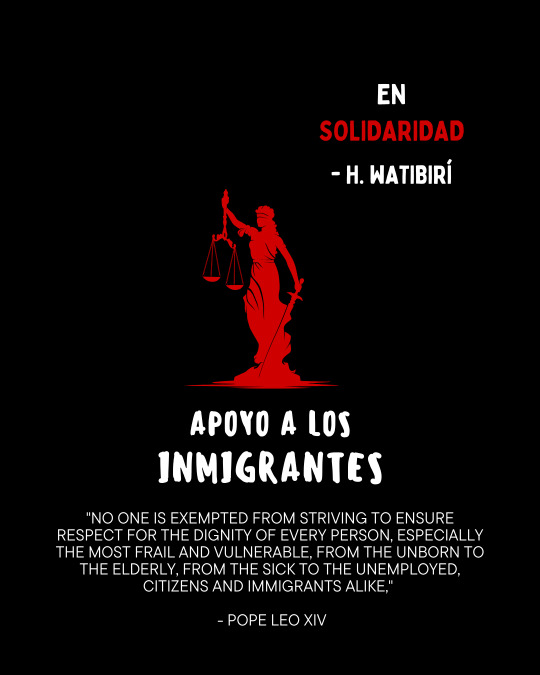
I believe in the rights and freedoms I was promised as an American citizen in the U.S. Constitution.
And the rights of everyone who touches the soil on this land. A land that has wept Native and Immigrant blood for over thousand years.
A Nation built off the backbone of immigrants from all over the world looking for asylum, peace, prosperity, and a life ruled by law and not a religious state.
The rights of Due Process.
Of Life, Liberty, and the Pursuit of Happiness. To not live in fear that rights are being slowly stripped away because of things beyond our control - like how and where we was born.
I was lucky that I was born in an era after the Jones Act and to Puerto Rican parents. My friends, co-workers, and those seeking asylum for various causes were not. And so I believe as the Pope and all humanitarians believe.
That we all have a right to be treated with dignity and respect no matter their circumstances or background. I am not here on this Earth to be judge and jury to no other man except myself. Only to serve and be of service to others so that we can all enjoy what makes life beautiful.
I hate the version of America playing out right before my eyes and am praying that we can reverse course before it's really too late.
0 notes
Text
El Chupacabra Retires to South Florida
This bizarre creature is an import to Florida in the past decade. The chupacabra actually made its debut on the world's weird list in 1975, after a series of farm-animal killings in Puerto Rico. Rural villages came forth with claims that an unidentified creature was killing their animals in the early-morning hours by biting their necks. It left strange puncturelike wounds on its victims that were inconsistent with any known species. People reported hearing screeching noises and flapping sounds as if made by the wings of a large bird. Eyewitnesses who claimed they had actually seen the creature generally, described it as about three or four feet tall, gray in color, with an oversized head, big oval eyes, and a mouth full of teeth. Another characteristic common in chupacabra reports is the sulfuric smell emitted by the creature. Some descriptions offered by witnesses implied the beast was a gargoyle-like being or a Tasmanian devil with webbed feet.
The rash of unexplained killings was first centered around Orocovis, in the mountain interior of Puerto Rico, where the mutilated remains of sheep, cows, goats, dogs, chickens, and other animals were found almost daily over a period of two months. According to one account, two hundred cows were killed by the mysterious entity. In accounts of goat killings, many people claimed the creature had literally "sucked the insides out of its victims through the eye sockets," leaving only carcasses of skin and bones. Since the bizarre beast lacked a name, locals dubbed it "the goat sucker," or, as translated in Spanish, el chupacabra.
Several prominent and credible citizens of Canóvanas came forward with sightings of an entity that "stood five feet high, with powerful hind legs like a kangaroo, big slanted eyes, and a ridge of fins or spines running down its back." One man claimed to have chased the creature, catching it briefly, long enough to look in its mouth and see long fangs before it broke free and disappeared. Chupacabra reports became so frequent that authorities could no longer ignore them. Police organized search parties to look for whatever was killing so many animals. Canóvanas's mayor, for lack of any other explanation, eventually blamed the animal deaths on feral dogs, though rumors began circulating that chupacabras were some kind of mutation resulting from a secret government experiencing. By 1996, chupacabra tales had spread throughout Latin America and among Florida's large Hispanic population.
The first suggested chupacabra report found by Weird Florida appeared in Sweetwater. (There are four Sweetwaters in the state. This one is a community of mostly Hispanics, located on Route 41 west of downtown Miami.) The report was made on March 10, when a woman said that an "inhuman thing" had crossed her property. This was followed by two more reports, about a strange animal killing two goats and twenty-seven chickens. That was enough to start the ball rolling.
On July 23, 1996, the evening news on most Florida television stations carried a story about a strange beast that was killing people's pets in South Florida and leaving behind a sulfuric smell. Although the C-word was never mentioned, rumors began circulating in Hispanic neighborhoods that this was indeed the work of a chupacabra.
In Tampa, two men reported that a chupacabra had killed some chickens, and claimed to have seen the creature on two different nights. We are left with three possible explanations for the appearance of these strange bloodthirsty creatures in Florida: The first is that they were imported from the Caribbean, perhaps on a cargo ship; the second is that it is mere folklore; and the third is that the infamous Jersey Devil has retired to South Florida. But before making any judgements, read what others have said about Florida's chupacabra.
Definitely a Chupacabra
I would side with the belief the animal mutilations in the Miami area were definitely caused by a chupacabra. When one is finally captured, I don't think it will be all that astonishing and will just be viewed as a new species. They have been seeing these animals for many years in the island and I think one somehow came on a ship and got loose. If you check, you will see that all the sightings have been near the Everglades, which is like the climate in the islands, and these animals would have no problem surviving. I looked at the map, and it appeared to be that all the sightings were right on the edge of the glades. -c7869
Chicken Takeout for Chupacabra
My grandparents live in Sweetwater. My grandfather had a coop that he kept chickens in. One night he heard noise around the coop, and the chickens were going crazy. He got up and went to loco with a flashlight. The coop is a large square frame covered with chicken wire and is partly covered on top with a flat roof. When my grandfather shined his flashlight, he saw something sitting on the roof that looked like a small kangaroo with big eyes that reflected red in the light. Whatever it was jumped off the coop and hopped away real fast. My grandfather said it really went fast, as fast as a dog can run. He then checked the coop, and out of eight hens, six were dead. One was lying outside, and the rest were inside. There was blood and feathers all over. Whatever it was tore the wire open, and that takes a lot of strength, so it wasn't anything like a possum or raccoon. This was in February 1997. I think it was the same thing people call the chupacabra. I asked my grandfather, but he had never heard of a chupacabra. His neighbors are Spanish, and when we told them what happened and I said something about a chupacabra, they agreed and said it could have been one. -Chuck W.
Her Boyfriend Saw One
My boyfriend is from Puerto Rico, and he told me about seeing one of these things when he was nine years old. He is 37 now and is well educated. He said that it looks like a kangaroo with horns and dorsal fins and has long claws. He said that he believes that one of these things was possibly shipped either on purpose as a pet or by accident to Miami and it escaped. -Alena
Chupacabra Cover-Up
The U.S. government does not want us to know about these creatures, because they are part of an ongoing genetic experiment and if somebody captured or killed one, it would blow their cover. All you have to do is look at where they have been seen. In Puerto Rico, they have been seen around that big telescope that belongs to the government. In Florida, all the sightings have been around the missile bases in Dade and Monroe counties and in Hillsborough County, near Eglin AFB. Now what does that tell you? -DZ
1 note
·
View note
Text
╭━ El Chupacabras es Boricua ━╮
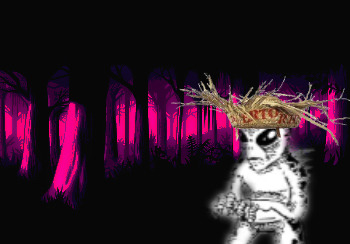
La historia de esta criatura ha sido una que ha recorrido todo el mundo. Desde los Estados Unidos hasta los rincones más lejanos como España, Chile, Filipinas y China. Pero este misterio tiene un origen.
La leyenda surgió en Moca Puerto Rico alrededor de 1975, cuando granjeros reportaron animales muertos misteriosamente en sus granjas. Causa de la muerte siendo desangrados por dos puntos de entrada en el cuello. En ese entonces, no se sabía que animal estaba causando las muertes de los ganados. En específico, cabras. Pero por el método en el que morían, el periódico Vocero reporta la noticia dandole otro nombre.
“El Vampiro de Moca.”
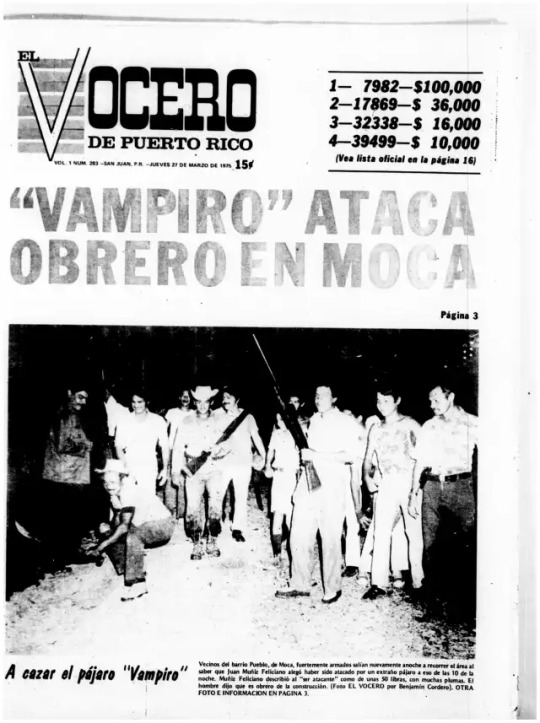
Luego en el 1995, volvieron a ocurrir muertes misteriosas de ganado en los pueblos de Orocovis y Morovis. Las muertes de varios animales por el mismo método llegaron hasta la cifra de 200 animales. El comediante Silverio Perez es referido como el primero en darle nombre a el causante de estas muertes.
El Chupacabras
Desde entonces, la historia del Chupacabras se vuelve internacional. Volviéndose una figura misteriosa la cual reportan casos cada cierto tiempo en distintas partes del mundo.
╰━━━━━∙⋆⋅⋆∙━━━━━╯
Referencias
1, 2, 3
0 notes
Text

Orocovis, Puerto Rico
21/abril/2025
16 notes
·
View notes
Text
LA VIDA DEL CAMPO EN PUERTO RICO: ENTRE TRADICIÓN, RESISTENCIA Y ESPERANZA
La vida rural en Puerto Rico sigue siendo un reflejo profundo de la identidad nacional, una mezcla de tradición, esfuerzo diario y conexión con la tierra. A pesar del avance urbano y los retos económicos, el campo puertorriqueño permanece como un bastión de cultura, autosuficiencia y orgullo. Desde las montañas de Utuado y Adjuntas hasta los valles fértiles de Orocovis y San Sebastián, miles de…
#agricultura en Puerto Rico#agroturismo boricua#campo puertorriqueño#cultura jíbara#jíbaro boricua#Mundo X News#Mundoxnews#noticias del campo#soberanía alimentaria PR#tradiciones del campo#vida rural Puerto Rico
0 notes
Text
Sonia Collazo, trailblazing activist for women and Latinos, has died at 76 - Philadelphia Inquirer
23, 1948, in Orocovis, Puerto Rico. Her father traveled to the mainland while in the military, and she spent time as a child in South Jersey. She …
View On WordPress
0 notes
Text
Lamentablemente muchos en Puerto Rico no entienden esto
Ciudadanos cuestionaron esta madrugada la labor del Departamento de Vivienda para manejar la cantidad de personas que se han interesado en el incentivo de placas solares de hasta $30 mil que se repartirá hoy a través de la isla.
Y es que, como NotiCentro pudo constatar y otros medios escritos reseñar en parte de las 10 oficinas regionales de la agencia, a las personas se le han dado 250 turnos —100 más que los que se informaron que habrían disponibles.
El secretario de Vivienda, William Rodríguez Rodríguez, había indicado que eran 6,000 espacios disponibles, divididos entre 4,000 de forma electrónica, 1,000 en centros de llamadas y 1,000 entre las oficinas —a 100 por cada local.
Hasta el momento, la dependencia pública no ha clarificado si la cantidad otorgada es para considerar quién cualifica y quién no, pues es necesario confirmar la elegibilidad para obtener el vale.
“Lo que no entendemos es porqué tan pocos centros y porqué tan pocos boletos, habiendo personas adultas que no dominan la tecnología…”, señaló Zabdiel Rodríguez en la Oficina de San Juan, ubicada en Las Vistas Shopping Village, donde la fila era muy extensa e incluso llegó a haber uno que otro altercado entre personas y funcionarios de Vivienda.
“Si no íbas a honrar los 250 estás dando 150 por encima. Tendrían que negarle a más del 100 porciento de los 100. No hace sentido que llegaras hasta 250”, agregó el hombre, quien dijo que llegó ayer martes a las 4:00pm.
Incluso, este medio de personas que ya estaban en la fila hasta tan temprano como las 6:00am del martes.
En Caguas, en el centro comercial Plaza del Carmen, El Nuevo Día informó ayer de personas recibiendo hasta1 152 turnos. Maretzie Díaz, subsecretaria de Recuperación de Desastres de Vivienda, le dijo al mismo medio que la cantidad de espacios disponibles en las oficinas no cambiaría aunque hubieran más ciudadanos.
En la primera repartición de vales, en el 2023, los 3,000 turnos que habían se acabaron en menos de una hora.
Última ronda del incentivo
Rodríguez Rodríguez indicó a inicios del mes que hoy, 31 de enero, sería la segunda y última ronda para solicitar el Programa Nueva Energía. Este programa ofrece una subvención para la compra e instalación de sistemas de energía solar, incluyendo placas solares y baterías recargables.
Nueva Energía se sufraga con los fondos CDBG-MIT y cubre el 100% de los costos, hasta un máximo de $30,000 para las personas que cualifiquen. El ingreso familiar del solicitante debe estar por debajo del 80% del Ingreso Medio del Área (AMFI, por sus siglas en inglés), lo que se traduce en un ingreso máximo de $33,600 para hogares compuestos por un solo individuo.
Para esta ronda estarán disponibles 6,000 boletos, lo que significa un incremento significativo en comparación con la primera ronda que contó con 3,000 boletos.
El Departamento de la Vivienda exhorta a los interesados a solicitar una cotización con alguna de las compañías instaladoras autorizadas que participan en el programa. Este paso servirá para garantizar que los participantes reciban una asesoría adecuada y así agilizar el proceso de recibir el beneficio.
“El miércoles 31 de enero a las 8:00 a.m. se comenzarán a entregar los boletos de turno y una vez el solicitante obtenga su boleto, deberá completar su solicitud con los documentos requeridos dentro de los próximos 120 días calendario”, explicó el secretario.
Los interesados podrán solicitar su boleto mediante la página web nuevaenergia.pr.gov, llamando al 1-833-234-2324, o acudiendo a uno de los centros de servicio en San Juan, Mayagüez, Vega Alta, Aguadilla, Hatillo, Caguas, Fajardo, Ponce, Yabucoa y Orocovis.
Las personas interesadas pueden obtener más detalles en nuevaenergia.pr.gov.
#mensaje para los puertorriqueños#puerto rico#politicos corruptos#despierta puerto rico#corrupción en puerto rico#esto es puerto rico#puertorriqueños#politicos de mierda#corrupt politicians#corrupción#despierta boricua#boricuas en florida#la corrupción en puerto rico#partido pnp de puerto rico#el partido mas corrupto en puerto rico#gobierno de puerto rico#el gobierno de puerto rico
0 notes
Text
Prichard Colon
Prichard Colon: A Fighter’s Story of Battle for Recovery and Justice
Prichard Colon made headlines in the professional boxing community and not just because of his incredible success in the ring. His story serves as a tribute to the resilience of the human spirit and the never-ending pursuit of justice, healing and hope.
Early Beginnings: Prichard Colon
Prichard Colon was born in Maitland, Florida on 19 September, 1992. When he was just 10 years old, his father Richard colon made a crucial decision of moving to Puerto Rico. Their intention was simple to allow Prichard a chance to compete in boxing and represent the territory. In order to go to the small Puerto Rican village of Orocovis, they had to leave behind their life in Florida, where they were living with Prichard’s mother and elder brother.
The Amateur Star
Prichard’s boxing career began at El Albergue (Athletic training center) in Salinas, Puerto Rico. At this training area, he was given the nickname “Digget,” which was due to his extraordinary height and a sign of big things to come. Prichard combined his studies in Business Administration at the Universidad del Sagrado Corazón in San Juan which displayed his commitment to both his education and his boxing career.
Prichard made headlines as an amateur boxer by taking home five national titles in the 141 and 152 pound weight classes. His outstanding achievement was celebrated as he took home the gold medal in the 64 kg division at the 2010 Pan American Youth Championship.
For More Information visit us our Website : celebritydecks
0 notes
Text
Pareja cae por precipio mientras corría "banshee" en Orocovis; muere joven de 19 años
(Facebook/Ángel Coira Rivera) Un joven de 19 años de edad falleció ayer tras caer por un precipio de más de 40 pies mientras corría un vehículo todoterreno tipo “banshee” por la carretera PR-157, en Orocovis. La víctima fue identificadacomo Ángel Coira Rivera. La otra persona que iba como acompañante era Robielys Berríos, de 22 años, quien resultó herida pero peramence en condición…
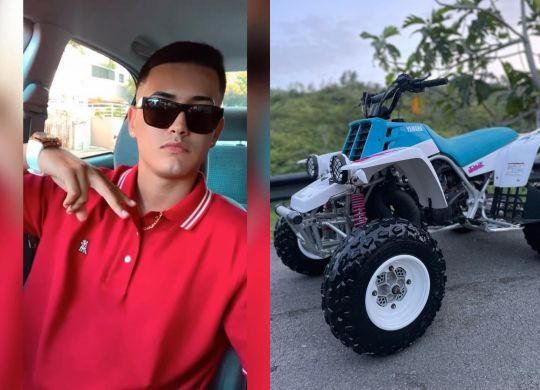
View On WordPress
0 notes
Text
Voces de la Montaña
Música, dirección y producción Dr. Irvin Santiago Díaz en el Taller Folklórico de la Montaña de Orocovis (787-391-0491) por Facebook Live auspiciado por La Fundación Banco Popular. Invitado el Cuatrista Alexis García. Acompañamiento Eduardo Maldonado Guitarra, Harold Rivera Güiro, Rubén Rojas Scooby Conga y Reymond Martínez Bongó. Desde Ruta 146 en Ciales el 8 de Julio del 2023. Saludos al…
youtube
View On WordPress
0 notes